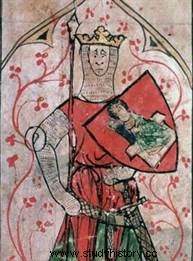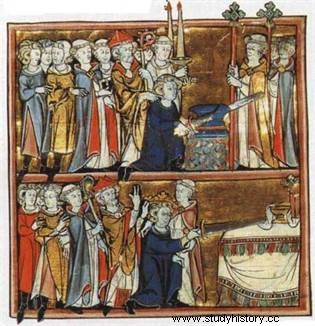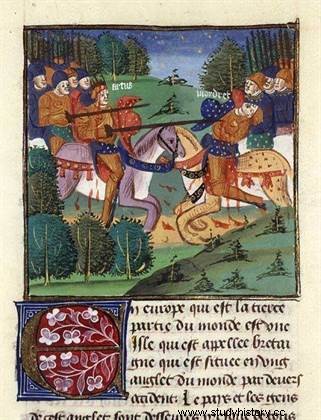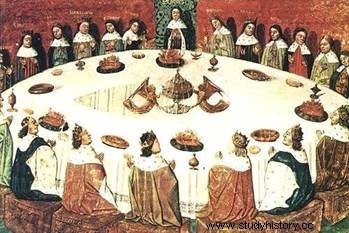 King Arthur and the Knights of the Round Table are the literary heroes of the Arthurian cycle whose success was immense from the Middle Ages. King Arthur brews many myths, the first of which is himself. King-knight, defender of his kingdom against the Saxons, owner of the legendary Excalibur, protected by the enchanter Merlin , he is also the fruit of adultery, a deceived husband, a betrayed friend and an incestuous brother. A heroic and tragic figure, therefore. But did Arthur exist? How did its myth develop and what has been its posterity until today?
King Arthur and the Knights of the Round Table are the literary heroes of the Arthurian cycle whose success was immense from the Middle Ages. King Arthur brews many myths, the first of which is himself. King-knight, defender of his kingdom against the Saxons, owner of the legendary Excalibur, protected by the enchanter Merlin , he is also the fruit of adultery, a deceived husband, a betrayed friend and an incestuous brother. A heroic and tragic figure, therefore. But did Arthur exist? How did its myth develop and what has been its posterity until today?
The legend of King Arthur
Debates about the historical reality of Arthur's existence have never really ceased. For some historians, he was a 2nd century Roman general. But for the majority, he would have been a warlord who lived in the context of the war between the Bretons and the Saxons, at the turn of the 6th century. Context taken up by the main Arthurian legends. If the figure of Arthur only really appears in the 12th century in The History of the Kings of Brittany of Geoffrey of Monmouth, there are some clues in older sources. While the chronicler Gildas and Bede the Venerable recount the events in which Arthur is said to have participated, but without mentioning his name, it is Nennius, in his Historia Brittonum (early 9th century), who mentions a dux bellorum named Arthur, victorious over the Saxons at the Battle of Mount Badon.
 In the 10th century, the Annales Cambriae tell the story of two battles in which Arthur would have participated, including that of Camlann (539), where he would have died with a certain Mordred. We can add to these sources Welsh legends from the 7th century, where we come across a sometimes brave, sometimes tyrannical Arthur, married to a Guinevere, and surrounded by companions including Cai (or Kaï, or Keu). Also in these legends Arthur did stop the Saxons.
In the 10th century, the Annales Cambriae tell the story of two battles in which Arthur would have participated, including that of Camlann (539), where he would have died with a certain Mordred. We can add to these sources Welsh legends from the 7th century, where we come across a sometimes brave, sometimes tyrannical Arthur, married to a Guinevere, and surrounded by companions including Cai (or Kaï, or Keu). Also in these legends Arthur did stop the Saxons.
In the 12th century, besides Geoffrey of Monmouth, who was in the service of Henry II Plantagenet , we can cite William of Malmesbury and his Facts of the Kings of England (circa 1125), which makes Arthur a courageous defender of Christianity against paganism. Monmouth's work was then extended by the Roman de Brut , by Norman Wace. If the chroniclers and princes of the time did not question the existence of Arthur, and this at least until Edward IV, the works in which he is quoted obviously cannot be considered as reliable proof of his existence.
These chronicles are political instruments , in particular under the Plantagenets, to register the English kings in the line of the Trojans of Brutus, son of Aeneas, in the context of the rivalry with the Capetians (who also claim a Trojan heritage). The character of Arthur, although of Celtic origin, is himself integrated into this tradition by Geoffrey of Monmouth and his English and Norman successors.
A “biography”
Make a historical biography of Arthur is therefore impossible, but making it a legendary biography is not easy as the character has inspired chroniclers and poets. By bringing together the major works of his legend and the Arthurian cycle, but also the Quest for the Grail, we can still try.
Arthur would be the son of the Breton king Uther Pendragon and the wife of one of his vassals, Ygern (or Ygraine). A ploy by Merlin the Wizard would have allowed Uther to take on the appearance of the Duke of Cornwall. Arthur was born in Tintagel and, as an illegitimate son, he is hidden by Merlin who entrusts him to a petty nobleman.
 When he came of age, when his father was long dead (killed in battle? poisoned by drinking from a spring ?), Arthur is recognized as legitimate king of the Bretons by managing to free the sword Excalibur (or Caliburnus) from the rock in which Uther had planted it.
When he came of age, when his father was long dead (killed in battle? poisoned by drinking from a spring ?), Arthur is recognized as legitimate king of the Bretons by managing to free the sword Excalibur (or Caliburnus) from the rock in which Uther had planted it.
Some barons nevertheless disputed its legitimacy, and King Arthur spent the first years of his reign fighting them. He begins to surround himself with knights, including one of the most illustrious of what will become the Round Table, his nephew Gauvain. Ally of Léodagant, king of Carmelide, Arthur goes so far as to fight in Gaul and, victorious, he marries Guinevere, daughter of Léodagant.
Begins a period of prosperity, until Lancelot du Lac , the best knight in the world, arrives at Arthur's court in Camelot. Very quickly a close friend of the king, the young man fell in love with Queen Guinevere, with whom began a relationship of adultery heralding the decline of the kingdom. Arthur himself succumbs to adultery, seduced by the enchantress Camille.
Lancelot's adventures however allow a reconciliation between the two friends (especially when the knight defeats the traitor Meleagant), who go to Gaul to punish Claudas, usurper of Lancelot's father , who especially took Guinevere prisoner. Victorious and the queen freed, begins the Quest for the Grail in which, however, Lancelot and Arthur do not participate, far too impure in the face of Gawain, Perceval and other Gilead...
Arthur's Death
Drama is never far away at Arthur's court, however. And it is still the relationship between Guinevere and Lancelot that makes matters worse; the betrayed king is taken in by his half-sister the fairy Morgane , who lives in the Brocéliande forest . The versions then diverge:it would be her, or their other sister Morgause, who would be the mother of Arthur's son, Mordred. Be that as it may, Arthur is guilty of incest, and begets the one who will cause his downfall. Back to Camelot , he must defend the honor of his queen, accused of attempted poisoning by Mador de la Porte. A knight in disguise (actually Lancelot) champions Guinevere, and her honor is safe. Only for a while since she falls back into sin with her valiant knight... It's too much for Arthur, who condemns his wife to the stake; but she is once again saved by Lancelot!
 The fight between the two friends ends with the victory of Lancelot, who spares the king for yet another reconciliation. The best knight of the king disappears, and Arthur - who has also forgiven his queen - then decides to resume his conquests in Gaul, and entrusts his kingdom to the son of Morgana (or Morgause therefore), Mordred . Bad idea:his nephew/son takes a liking to power, and especially to Guinevere, whom he even ends up molesting! Arthur returns to Britain and confronts Mordred at the Battle of Camlann (or Salisbury); father and son kill each other, and most of the Knights of the Round Table also pass away!
The fight between the two friends ends with the victory of Lancelot, who spares the king for yet another reconciliation. The best knight of the king disappears, and Arthur - who has also forgiven his queen - then decides to resume his conquests in Gaul, and entrusts his kingdom to the son of Morgana (or Morgause therefore), Mordred . Bad idea:his nephew/son takes a liking to power, and especially to Guinevere, whom he even ends up molesting! Arthur returns to Britain and confronts Mordred at the Battle of Camlann (or Salisbury); father and son kill each other, and most of the Knights of the Round Table also pass away!
Before dying, the king orders one of the survivors, Girflet, to throw Excalibur into a nearby lake:a female hand (that of the Lady of the Lake, which raised Lancelot) retrieves the sword. Meanwhile, Morgana has taken Arthur's body to the Isle of Avalon.
The tomb of King Arthur
Becoming a popular hero in the Middle Ages, Arthur is also, as we have mentioned, a political issue. The most famous example is its recovery by the King of England, Henry II Plantagenet, at the end of the 12th century. Taking advantage of the popularity of the Arthurian legend, Henry II made arrangements with the Benedictine monks of the Glastonbur Abbey y so that they can discover the tomb of King Arthur there! This timely update allows the famous abbey to assert itself against Canterbury, and even declare itself the location of the legendary Isle of Avalon .
As for the King of England, he does a double blow:he definitively kills Arthur, pride of the Welsh still quick to disobey his throne, and recovers his legend to his own profit by integrating the king of the Bretons into the history of the kings of England, thus posing as one of Arthur's successors.
Knights of the Round Table
 Arthur's popularity quickly spread to England, especially from Chrétien de Troyes , which makes the Breton king the center (admittedly passive) of his work, even if the main characters of his writings are rather Lancelot, Perceval, Yvain or Gauvain. It is therefore quite logical that he is integrated at the beginning of the 14th century among the Nine Preux. These are heroic characters brought together by Jacques de Longuyon, a writer from Lorraine, in his Roman d'Alexandre:Hector, Alexander, Caesar, Joshua, David, Judas Maccabee, Arthur, Charlemagne, Godefroy de Bouillon.
Arthur's popularity quickly spread to England, especially from Chrétien de Troyes , which makes the Breton king the center (admittedly passive) of his work, even if the main characters of his writings are rather Lancelot, Perceval, Yvain or Gauvain. It is therefore quite logical that he is integrated at the beginning of the 14th century among the Nine Preux. These are heroic characters brought together by Jacques de Longuyon, a writer from Lorraine, in his Roman d'Alexandre:Hector, Alexander, Caesar, Joshua, David, Judas Maccabee, Arthur, Charlemagne, Godefroy de Bouillon.
The legendary king thus appears among the Christian Valiants , and then develops a rich iconography during the fourteenth century, and the following. We can cite the illuminations of the Book of the Errant Knight (Thomas de Saluzzo, 1395), the wall paintings of the castle of La Manta, in Piedmont (in the years 1415-1430), tapestries belonging to Louis d'Anjou, Charles V and Philippe le Bon, or medallions in enamel in the 16th century. Arthur's presence among the Nine Preux contributes almost as much to his posterity as the success of the Arthurian legends and the works of Chrétien de Troyes.
Arthur's popularity soon spread throughout Medieval Europe , far exceeding France and England, to reach as much Norway as Italy or Germany. Popularity that lasts to this day, mainly through the work of Chrétien de Troyes, but even more so through Thomas Malory and his Le Morte Darthur , from which John Boorman is largely inspired in his film Excalibur (1981), which remains today the cinema reference on the Arthurian subject.
Bibliography
- T. Delcourt (dir),The Legend of King Arthur , BNF/Seuil, 2009.
- King Arthur, by Alban Gautier. PUF, 2018.
- Mr. Aurell, The Legend of King Arthur , Perrin, 2007.
